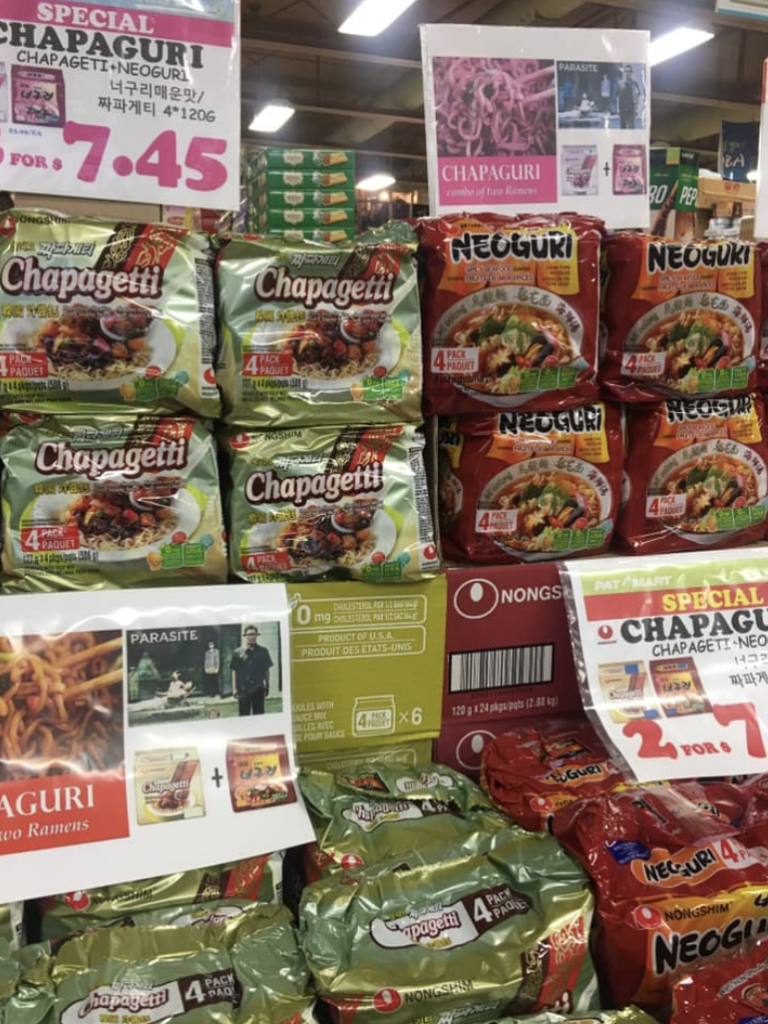What Is Ram-Don From The Movie ‘Parasite’ And Why Is Everyone So Obsessed With It?
After 'Parasite', searches for "ram-don" grew by 400% globally. So what is the illusive dish and why is everyone so obsessed with it?

If you’ve seen Parasite, you’ll definitely remember the enthralling ram-don scene.
Surpassed only by the birthday party, the ram-don moment featured the most action in the film’s entire two-hour running time. In case you’ve already forgotten, the action bubbles up when Mrs Park calls Mrs Kim after her family had to cut Da-Song’s birthday camping trip short.
*Parasite spoilers ahead*
As the Parks drive home, Mrs Park tells Mrs Kim that a bowl of ram-don should be ready for her son by the time they arrive. Flustered and with no clue what ram-don even is, Mrs Park quickly combines a couple of packets of instant noodles and throws in some cubed sirloin.
While she cooks, the rest of the Kim family hurry to clean the Park’s home that they drunkenly trashed. During this time, the Kims also force the old housekeeper and her husband back down into the secret bunker basement. As the Park’s arrive home, each member of the Kim family hide under beds and tables to escape being found. During this time, Mrs Kim kicks the old housekeeper down the stairs, which leads to her untreated concussion and subsequent death.
Good afternoon to the ram-don scene only pic.twitter.com/KOOdDfEgXq
— Bong Joon Ho Hive President (@dyanatheesaint) January 20, 2020
So What Is Ram-Don?
Following the release of Bong Joon-Ho’s Oscar winning Parasite, searches for “ram-don recipes” increased by more than 400% globally, according to Google. Similarly, searches for “asian supermarket” within Australia and the US have soared by over 350% since the awards show.
While curiosity around ram-don has grown, the high number of searches for the dish can also be attributed to the fact that ram-don isn’t actually a Korean dish. Instead, ram-don is the term that Darcy Paquet, the translator for Parasite, coined when subtitling the film in English.
The combination of the words “ramen” and “udon” was used to represent the hard-to-translate Korean dish, jjapaguri. Jjapaguri, also known as chapaguri, is the combination of two instant noodle packs by the brands Chapagetti and Neoguri.
As the Chapagetti noodles are ramen-type and the Neoguri are udon-type noodles, the name ram-don was an easy combination of the two. However, Jjapaguri, a common comfort food in South Korea is not normally topped with steak, let alone an expensive sirloin cut — further demonstrating the class divide shown throughout Parasite.
The Impact Of Parasite On The Instant Noodle
The instant noodle market within South Korea has always been massive. In 2016, it was estimated that the domestic instant noodle market was worth 1.13 trillion South Korean won (approximately 1.4 billion Australian dollars).
The export of Korean noodles themselves exceeded $400 million last year following the global popularity of spicy noodles. This spicy noodle craze likely occurred through the rise of mukbang videos, and in particular, the obsession with the Korean Fire Noodle challenge.
So while instant noodles have always been a big hit in South Korea, Parasite has had a wider global impact on instant noodles since its release. If you search “ram-don” on YouTube, you’ll be met with countless videos about ram-don — from cooking tutorials all the way to mukbangs with the popular dish.
Korean noodle brand Nongshim even released an “official chapaguri recipe” video to capitalise on the newfound global success of instant noodles. Most recently, Binging with Babish — the YouTube channel that recreates popular foods in film — released his recreation of the dish to his 6.14 million subscribers yesterday.
Beyond videos online, some Asian grocers have even changed strategy in how they market their instant noodle offerings. Take the Korean PAT Supermarket chain in Canada, which has started selling special priced deals to encourage the sale of Neoguri and Chapagetti. Alongside images of the Parasite poster, the Ontario PAT store gave a very simple run down of how the dish is made through photos.

Donna Yu / @subtleasiantraits
What Is The Significance Of Ram-Don In Parasite?
While ram-don is not traditionally served with steak in Korea, the addition of an expensive cut of meat just further highlights the concept of wealth disparity in Parasite.
Both Chapagetti and Neoguri are relatively cheap instant noodles, making it affordable for the poor. So the fact that Mrs Park requests Hanwoo — a luxury Korean beef that is even more expensive than Japanese Wagyu — to be added shows just how differently the two families live.
Bong Joon-Ho explained that the addition of the expensive cut of steak distanced Mrs Park from the idea that instant noodles are a dish accessible by all. “[Ram-don] is something kids like, regardless of the rich or the poor,” Bong told the LA Times. “But the rich wife couldn’t stand her kid to eat this cheap noodle, so she adds sirloin topping.”
when you want to make ram-don but can’t afford the sirloin steak thus underlining one of the many metaphors on class distinctions that bong joon-ho artfully inserts into the film
— momo (@guacamomole) February 16, 2020
The elevated instant noodle comfort dish is only one example of the running theme of food representing class struggle throughout Parasite. After all the Kim family start the film scrounging what little money they can by assembling pizza boxes for a fast-food chain in their semi-basement home.
Then once Ki-woo and Ki-jeong infiltrate the Park family, they get their mother a job by using expensive peaches against the long-time (and very allergic) housekeeper. The never-ending supply of fresh fruits — a famously expensive food in Korea — in the Parks’ home is just another reminder that the poor and rich live very different lives. And while food is eventually what pulls the Kims out of poverty, it’s ultimately what also spells out their downfall. That is, Da-song’s food filled-birthday party, which resulted in Mr Kim’s fate and Ki-jeong’s death.
While food represents a lot in Parasite, the ram-don that Mrs Kim whips up does look pretty delicious. If you’re interested in trying to make ram-don for yourself, here is a quick two-minute tutorial that has gone viral online:
Ram-Don (Jjapaguri) with Steak
(from 4x Oscar winning film, Parasite) ????? pic.twitter.com/W58DaADb7c— newt⁷ (@milktpapi) February 18, 2020

